Directory Structure
This is the structure of my app now that it is running locally:

Environment
Linux Mint 17 Cinnamon
Steps To Replicate Locally
01) MongoDB 2.4.9 - DONE
Install instructions for MongoDB 2.4.9 on Linux Mint 17:
http://docs.mongodb.org/v2.4/tutorial/install-mongodb-on-ubuntu
02) RockMongo 1.1 (which requires Apache, PHP and MongoDB Driver) - DONE
sudo apt-get install apache2 php5
sudo apt-get install php5-dev php5-cli
sudo apt-get install php-pear
pear version
pecl version
sudo pecl install mongo
At this point, I was prompted with something that included [no] and I just pressed Enter.
cd /etc/php5/apache2
sudo vi php.ini
Add this to the end of the file:
extension=mongo.so
Then restart:
/etc/init.d/apache2 restart
Then install RockMongo:
cd /var/www/html
wget https://github.com/iwind/rockmongo/archive/1.1.7.zip
unzip 1.1.7.zip
mv rockmongo-1.1.7 rockmongo
rm 1.1.7.zip
03) Create clean virtualenv environment and install packages to it - DONE
virtualenv is a Python package that lets you create independent, virtual environments containing their own Python installation and packages.
Install virtualenv through Synaptic Package Manager.
How To Create
https://code.google.com/p/modwsgi/wiki/VirtualEnvironments
By the author of mod_wsgi, Graham Dumpleton.
Why To Create
http://www.dabapps.com/blog/introduction-to-pip-and-virtualenv-python/
This article is so brilliant it almost make me want to cry, kudos, kudos.
Commands
Before doing the following, install python2.7-dev, libxml2-dev, libxslt1-dev and apache2-dev via Synaptic Package Manager to resolve errors when doing pip installs later.
# change to your html folder
cd /var/www/html
# this will create a folder called ENV that contains its own instance
# of python without inheriting your system's installed python packages.
# it will also install independent instances of pip and setuptools.
# the --no-site-packages option is the default setting in recent versions
# however I added it just to be sure.
virtualenv --no-site-packages ENV
New python executable in ENV/bin/python
Installing setuptools, pip...done.
# you can 'activate' the virtual environment so that each time you use
# pip it automatically installs packages in the virtual environment.
# change to your virtual environment folder
cd /var/www/html/ENV
# activate the virtual environment
source bin/activate
# you can deactivate this by typing 'deactivate` and it is also
# automatically deactivated each time you close the terminal.
deactivate
# from time to time you can save the names of the packages you have
# installed to your virtual environment via pip to a text file with:
pip freeze > requirements.txt
# note, after installing virtualenv as shown above, you will have some
# packages installted by default.
pip freeze
argparse==1.2.1
wsgiref==0.1.2
# requirements.txt would allow installation of all required packages via:
pip install -r requirements.txt
# install packages, whilst virtualenv is activated
pip install bottle
pip install https://github.com/FedericoCeratto/bottle-cork/archive/master.zip
pip install requests
pip install pymongo==2.6.2
pip install beautifulsoup4
pip install lxml
pip install Beaker
pip install pycrypto
pip install pillow
pip install tldextract
04) Copy existing application files to new location - DONE
cp -r path/to/open_shift_apps/my-app/. /var/www/html
05) Remove files and folder unnecessary for *local* production from var/www/html - DONE
rm -r data
rm -r libs
rm -r .openshift
rm -r .git
rm setup.py
rm setup.pyc
rm setup.pyo
06) mod_wsgi - DONE
Through Synaptic Package Manager.
Apache wouldn't work for me unless mod_wsgi was installed at system level, ie it didn't work when mod_wsgi was installed within virtualenv.
07) Understand the relationship between the Apache server, mod_wsgi and your application - DONE
Apache
To run a dynamic website locally, you need a server, in this case we used Apache.
mod_wsgi
mod_wsgi is an Apache module which extends Apache so that rules can be added to its configuration which point to your Python code so that it can be run when a user visits a particular path.
08) Configure Apache rules
/etc/apache2/sites-available/000-default.conf
WSGIPythonHome /var/www/html/ENV
WSGIPythonPath /var/www/html:/var/www/html/ENV/lib/python2.7/site-packages:/var/www/html/wsgi
<VirtualHost *:80>
# for all content in static folder - css, js, img, fonts
Alias /static/ /var/www/html/wsgi/static/
# for rockmongo
Alias /rockmongo /var/www/html/rockmongo
<Directory /var/www/html/rockmongo>
Order deny,allow
Allow from all
</Directory>
ServerAdmin webmaster@localhost
DocumentRoot /var/www/html
WSGIScriptAlias / /var/www/html/wsgi/application
ErrorLog ${APACHE_LOG_DIR}/error.log
CustomLog ${APACHE_LOG_DIR}/access.log combined
</VirtualHost>
When a user visits a particular path, Apache looks for an application object which contains code which will run your Python program.
In this case, the object is located at wsgi/application and is triggered when the user goes to localhost.
/var/www/html/wsgi/application
from mybottleapp import application
09) Check file ownership and permissions
If things don't work at any stage of the process, be sure to look at the permissions of your local files. Not having the right permissions could mean that your application is not imported.
10) mongodump from OpenShift and mongorestore locally
How to mongodump from OpenShift and mongorestore locally on MongoDB 2.4.9?
Further Reading
How Python web frameworks, WSGI and CGI fit together
https://docs.python.org/2/howto/webservers.html
http://wsgi.readthedocs.org/en/latest/servers.html
https://code.google.com/p/modwsgi/
https://www.python.org/dev/peps/pep-0333
http://bottlepy.org/docs/dev/deployment.html#apache-mod-wsgi
